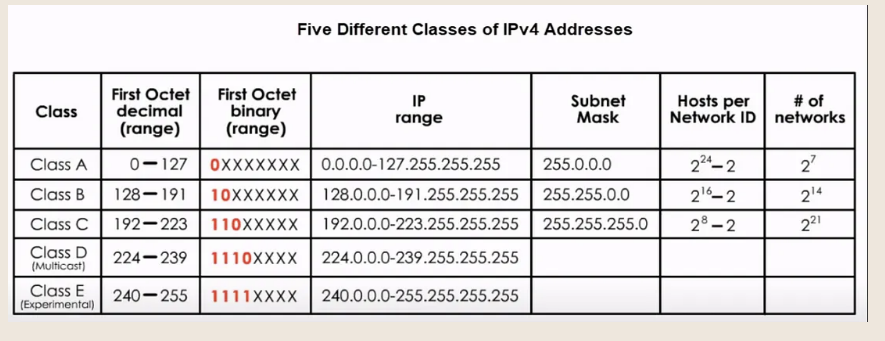IP Address-Network Layer
The Network Layer
IP Address
IP (Internet Protocol) Address- 32 bit/4 byte long numbers made of four octets. Each octet normally represented in decimal numbers.
Belong to networks, not the devices attached to those networks/ a way to identify where we are in relation to who we are/ logical address that is given
Two types:
IPv4 IPv6
Each Octet = 8 bits
Dotted-decimal notation
Dynamic Host Configuration Protocol
Dynamic IP Address-
Sometimes reserved for clients
Static IP Address- must be configured on a node manually
In some cases, static IP addresses are reserved for servers and network devices.
IP Address Classes
IP address can be split into 2 sections:
Network ID
Host ID
portion that can be assigned to the host device on the network. the size of the network/ determines how many Ip addresses you can have on that network
Subnet mask - determines what is network or host id/ 32 bit/ determines size of the network
Subnetting
binary 1 1 0 0 0 0 0 0. 1 0 1 0 1 0 0 0. 0 0 0
IP address:192.168.1.1
Subnet Mask: 255.255.255.0
AND (ANDing)
used to determine the network and host portion
compares bit for bit
also 32-bit
host portion: Ip portion that can be assigned to a node/ host
network: first Ip address on the network, where 1s end
cant have 0 before the host
Address class system- a way of defining how the global IP address space is split up
3 primary address classes:
Class A- where the first octet used for the network ID, last three are for the host ID (1:3)
Class B- where the first two octets are used for the network ID and the last two octets are for the host ID (2:2)
Class C- first three octets are for the network ID and last octet is for host ID (3:1)
IP Structure
1 octet- 32 bit-4bytes
Each octects-8 bits-1byte
each octet divided by .
Classful : a technique of allocating IP address that divides them into categories/ default mask
Classless: is a technique of allocating IP address that intended to replace classful addressing order to reduce IP address depletion
Prefix length- another way to annotate the subnet mask represented with /
the amount of bits set to 1 on the network
Public and Private IPv4 Addresses
public-globally routed between internet service provider (ISP) routers
private-not globally routable (i.e.: when communicating locally, LAN)
Loopback addresses - special network/ private
Link-Local Addresses- special network /private/ automatic private internet protocol address
Classless inter-domain routing (CIDR) can be used interchangeably with Prefix Length
Data Link Layer
Unicast, Multicast, & Broadcast
Unicast- receive one receiving address
signified by a 0 in the first octet of a destination address. It means the ethernet frame is intended for ONLY the destination address
Multicast- sends data from single source to multiple recipients on the network at the same time
Broadcast- send/transmit by means of radio, television or by streaming over the internet / one to all the devices
Assignment of IP Addresses
Internet Assigned Number Authority (IANA)- manages and allocates blocks of IPv4 and IPv6 addresses of five regional Internet Registries (RIRs)
Internet Registries RIRs
Segmenting Networks
Segmenting -dividing ips into smaller networks
ARP- a protocol used to discover the hardware address of a node with a certain IP address
ARP table- a list of IP addresses and the MAC addresses associated with them / generally expire after a short amount of time to ensure changes in the network are accounted for.
IP- 32 bit number
IP Phone- like having extensions in an office/ connecting one cable to the switch from the pc and phone. More efficient use
Parts of a IP Datagram:
• IP datagram- a highly structured series of fields that are strictly defined
• Total Length field- indicates the total length of the IP datagram it's attached to
• Identification field- a 16-bit number that's used to group messages together
• Flag field- used to indicate if a datagram is allowed to be fragmented or to indicate that the datagram has already been fragmented
• Fragment Offset field/ Fragmentation- the process of taking a single IP datagram and splitting it up into several smaller datagrams
• Time to Live (TTL) field- an 8-bit field that indicates how many router hops a datagram can traverse before it's thrown away/ also has valuable trouble-shooting protocols
• Protocol field- another 8-bit field that contains data about what transport layer protocol is being used
• Header checksum field- a checksum of the contents of the entire IP datagram header
• IP options field- an optional field and is use to set special characteristics for datagrams primarily used for testing purposes/ usually followed by a padding field
• Padding field- a series of zeros used to ensure the header is the correct total size
• Network- collaboration of multiple nodes that are interconnected together
